Improvement over the OLSR Routing Protocol in Mobile Ad Hoc Networks by Eliminating the Unnecessary Loops
Автор: Shahram Behzad, Reza Fotohi, Shahram Jamali
Журнал: International Journal of Information Technology and Computer Science(IJITCS) @ijitcs
Статья в выпуске: 6 Vol. 5, 2013 года.
Бесплатный доступ
Mobile ad hoc networks are type of wireless networks in which any kind of infrastructure is not used, i.e. there are no infrastructures such as routers or switches or anything else on the network that can be used to support the network structure and the nodes has mobility. The purpose of this paper is to provide a better quality of the package delivery rate and the throughput, that is in need of powerful routing protocol standards, which can guarantee delivering of the packages to destinations, and the throughput on a network. For achieving this purpose, we use OLSR routing protocol that is a responsive protocol and is currently covered under the IETF standard (RFC 3626). At this paper, we improved the OLSR routing protocol by eliminating the unnecessary loops, and simulation results demonstrated a significant improvement in the criteria of package delivery rate and throughput.
Mobile Ad Hoc Networks, Routing, Routing Protocol, OLSR, Dynamic, Topology
Короткий адрес: https://sciup.org/15011908
IDR: 15011908
Текст научной статьи Improvement over the OLSR Routing Protocol in Mobile Ad Hoc Networks by Eliminating the Unnecessary Loops
Published Online May 2013 in MECS
-
II. Related Works
OLSR is a routing protocol for mobile ad hoc network that has been presented by the MANET working group in the IETF [6]. This protocol acts responsively. OLSR will harm by high variability that is caused by the topology and nature of the traffic. This suggests that, the service quality characteristics may be affecting the performance of OLSR protocol. In [7], the nodes, based on their existing resources, are divided into three categories of service quality nodes, router nodes and receiver nodes. Nodes declare and report their characteristics to their neighbors by sending “HELLO” massages. Each node can specify the categories of its neighbors by receiving the HELLO message from them. Only the service quality nodes can participate in the service quality routing operation. The OLSR routing method is employed for routing. In [8] this is shown that, the OLSR has capability for the quality of routing. In [8] it is also proven that, the existence of more accurate frequent updating will cause positional information throughout the network. General Electronics Company and colleagues [9], create a model of OLSR protocol based on bandwidth of the status link in terms of service quality criteria. This protocol tries to find routes that have the highest bandwidths in bottlenecks. To provide a better service quality (i.e. to provide the route with optimum bandwidth), it is necessary to broadcast the bandwidth changes to calculate the best route with bandwidth correctly. Collagen and colleagues [9] study the impact of MPR 4 coverage parameter increasing. In addition, concludes that, when the redundancy of topological data and transmissions increase due to the extensive coverage of MPR, despite having average mobile nodes, too many packages are delivered. The study that was carried out in [9] has been further developed in the research [10]. This research emphasizes studying the effect of MPR coverage parameters and TC redundancy adjustments on the OLSR performance. The above-mentioned research suggests that the delivery level will not be affected by overload that is caused by redundant promotional data. Both references [9,10] emphasize having more detailed information on the network surface and about how it effects on the routing protocol performance. In other words, they study the impact of OLSR protocol parameters adjustment in terms of the network status (i.e. nodes and links) rather than the situational information of nodes and links.
-
III. Routing Protocols in Mobile Ad Hoc Networks
-
3.1 Simulation Model
Routing in the suggested algorithm is based on routing established upon demand. Each node has a routing table in which the node keeps its own routing information. The routing table contains fields such as the destination node address, the next node address, the sequence number, the distance, the minimum requested bandwidth; the maximum permitted delay, the stream type and the route validity period. The destination node address field specifies the address of the destination node. The next node address identifies the next node on the route for sending packages to the destination. The sequence number field is used to avoid the routing loops formations and repeated transmissions. As a routing message reaches to a node, if the sequence number of the received message for a specific destination node is greater than the sequence number for that specific node in the routing table, the message will be processed. This simple act will prevent from repeatedly sending of the routing packages and avoid the creation of routing loops in routing packages transmission. The distance field specifies the route length. The minimum requested bandwidth specifies the minimum amount of bandwidth required by the stream. This field is required only in cases of service quality streams (flows which require the service quality) and will be processed only when the stream type is of quality service. The maximum permitted delay field determines the maximum tolerable delay for the service quality streams. This field is also used only when service quality streams are being sent. The stream type is determined by the stream type field. This field can have the service quality level or the best effort. This field specifies the type of requested service. The validity period field determines the period in which a route is valid. After passing this period, the route will not be valid no more. If this field receives a package for a destination before the end of validity period, the field will be re-initialized. Routing protocols in mobile ad hoc networks can be divided into two categories of table-based or proactive protocols and need-based protocols, the table-based or proactive protocols are used for periodic updating of the links, the routes information are kept in a table and are used whenever they are needed. However, need-based protocols do not require keeping the routes data, and whenever a route is needed, they start to explore a route based on the source location.
In this category of protocols, each node keeps one or more tables containing routing information to the other nodes of the network, all nodes update their tables to maintain consistency and to have an up to date view about the network. As the network topology changes, the nodes broadcast updating messages throughout the network. This category of protocols is distinctive by the manner of distribution of information about topology changes throughout the network, and by the number of tables that are required for routing. WRP 5, DSDV 6,
-
5 Wireless Routing Protocols
-
6 Dynamic Destination-Sequenced Distance-Vector
-
3.2 Need-Based Protocols
FSR 7, HSR 8, GSR 9, ZHLS 10 and CGSR 11 are some examples of table based protocols.
In comparison with table-based routing protocols, in this category of protocols, not all updated routes are stored on each node; instead, the routes will be constructed whenever they are needed. When a source node wants to send one message to a destination, it will request the route discovery mechanisms to find a route to the destination (RREQ). Route remains valid until the destination is available or if is not for the long-term needs. Once a route to the destination is found, the RREP mechanism sends, in reverse, the route to the source node. CBRP 12, AODV 13 , DSR 14, TORA 15 ABR 16 are some examples of need-based protocols.
-
IV. OLSR Routing Protocol
OLSR is a routing protocol for mobile ad hoc network that has been presented by the MANET working group in the IETF [11,13]. This protocol acts responsively. The network nodes exchange the topology information periodically with each other, thus, the optimal route between any two-network nodes is always present. An optimization that, in comparison with the other status link protocols, has been done in this protocol is to create the concept of MPR. In this protocol, the network nodes are responsible to select a set of their neighbor nodes as MPR set. This set must be chosen in such a way that covers all nodes, which are distant as two steps from the selected node. This protocol recognizes its neighbors and records their network addresses, measures delays or cost towards its neighbors, and exchanges information by forming a package that represents the whole of the information. It sends these packages to all of the routers and calculates the shortest route to every other router. The OLSR routing protocol has the following features: (1) resends only the MPR control messages, (2) reduces the size of the control messages, (3) reduces the network overload, (4) is one stable protocol, (5) is one proactive protocol, (6) doesn’t depend on any central entity, (7) supports the nodes mobility and dynamism, (8) is appropriate for dense networks and (9) OLSR protocol involves several steps: generation of the control packages, sending the packages to other nodes, making the shortest path tree (by using the Dijkstra’s algorithm) and generation of the routing table. In OLSR, the MPR (Multipoint
-
V. Our Proposed Method: Improving the OLSR Protocol is Too Short.
In our suggested method, when a node sends a package to other nodes within its own radio range, packages will be transmitted by nodes called MPR to the other nodes. Consequently, if the package falls into a loop, then two cases occur; (1) if the package used less number of steps (less than 255 steps) to reach the destination, and the package is IP Header, then we set dynamically its number of steps to zero to give the package the second chance to reach the destination, and (2) if the package used more number of steps (more than 255 steps), and the subjected package isn’t IP Header, then we eliminate the package, because, otherwise, many packages will remain in the network and this will cause network traffic, bandwidth occupation, high level of delay in the package delivery, and finally, the reduction of package delivery rate and network payload rate. In our suggested method, by eliminating the unnecessary loops, the package delivery rate (PDR) and the throughput is improved by about 20 percent. In this method, by eliminating the unnecessary loops and setting conditions, we prevented from eliminating these packages and consequently improved the package delivery rate and throughput in the network.
-
VI. The Simulation Setup and Evaluation Parameters
-
6.1 The Simulation Model
-
6.2 The Simulation Parameters
In this simulation, we used a wireless network with 802.11 standards, which is a 1000 * 1000-simulation environment. According to, we employed 802.11 protocols for the network layer, with node transmission range of 250m, link bandwidth of 11 Mpbs, package size of 512 bytes and simulation time of 200s. We evaluated the OLSR efficiency by storing (keeping) the network pace; stop time and size change (the number of mobile nodes). Table.1 shows a summary of the parameters that have been used in this simulation.
Here we emphasize the performance evaluation of OLSR routing protocol by using the NS simulator, that is an object oriented and Discrete Event Driven simulator. The NS 17 software is generally used for simulation of the local computer networks and wide area networks. We could simulate the OLSR protocol by using the latest version of the NS-allinone-2.35 and patching um-olsr-2.35_v0.8.8 version of the OLSR protocol in NS-allinone-2.35. Although, NS can be implemented on different operating systems, but in this paper, we use the Back Track 5 Linux operating system, which is being employed for a number of programming tools with simulation process, to run the simulation of NS-allinone-2.35.For Simulation and its implementation, we should firstly design our network scenario in OTCL language that gives us the output as trace. In addition, we use XGAPH to show the graphs, and finally, we employ the auxiliary (supporting) program of NAM to analyze the performance of nodes and how the packages are being sent and eliminated [13].
Table 1: Values of parameters for OLSR simulation
|
Simulator |
NS2 2.32 |
|
Protocol |
OLSR |
|
Simulation duration |
30,40,50,60,70 |
|
Simulation area |
1000 m X 1000 m |
|
Number of nodes |
20,30,40,50,60 |
|
Transmission range |
250m |
|
MAC Layer Protocol |
IEEE 802.11 |
|
Pause time |
200 Sec |
|
Maximum speed |
20 m/s |
|
Traffic type |
CBR (UDP) |
|
Data payload |
512 bytes/packet |
|
Packet Size |
256 |
PDR is the number of packages that are delivered to the destination from the source, divided by the total number of packages in the network. This parameter is also called as “success rate of the protocols”:
PDR = ( SendPacketNo / RecievePacketNo ) * 100 (1)
Where PDR is the package delivery rate, SendPacketNo is the number of sent packages, and RecievePacketNo denotes the number of received packages.
Throughput: a network can be measured by using the different tools that are available on the different operating systems. This page explains the theory, on which the adjustments of these tools for measurements are based, and the issues related to these measurements. The reason for measurement of the throughput in networks is that, the people often intend to know about the maximum operational power of data in a connection link or network access as expressed by the unit of bit per second. The measurement of this quantity is commonly carried out by transmitting a large size file from one system to another and calculating the required time for complete transmitting or copying of the file. Then, with dividing the file size by that time, the throughput will be achieved in unit of megabit per second, kilobit per second or bit per second. The following formula shows how to calculate the throughput:
-
X = C / T (2)
Where X is the throughput, C is the number of requests that are accomplished by the system, and T denotes the total time of system observation.
-
VII. Simulation Results
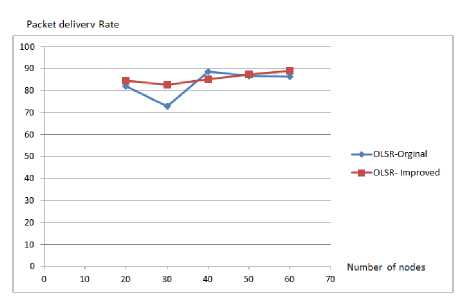
Fig. 1: PDR OLSR Original and OLSR Improved (Duration = 30)
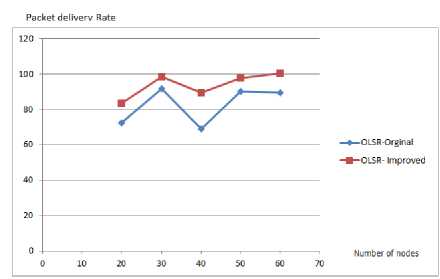
Fig. 4: PDR OLSR Original and OLSR Improved (Duration =60)
Fig.1 it shows that, the package delivery rate at the time of 30, when the number of nodes reaches as 40, the conventional OLSR performs better than our method, but in the other nodes, our improved OLSR has the best performance.
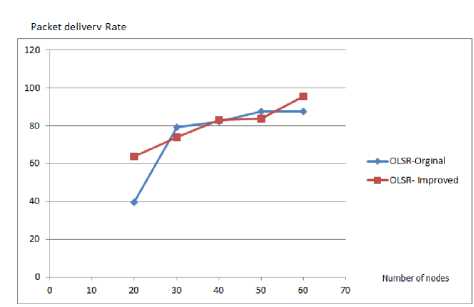
Fig. 2: PDR OLSR Original and OLSR Improved (Duration = 40)
Fig. 2 it shows that, the package delivery rate at the time of 40, when the number of nodes is 30 to 50, the conventional OLSR performs better than our method,but in the other nodes,
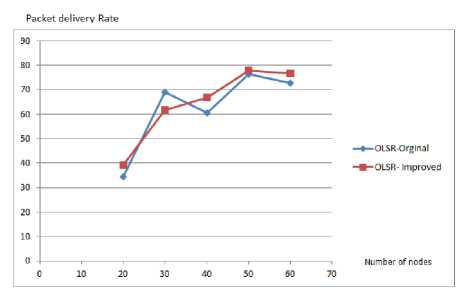
Fig. 3: PDR OLSR Original and OLSR Improved (Duration = 50)
Fig. 3 it shows that, the package delivery rate at the time of 50, when the number of nodes is 30, the conventional OLSR performs better than our method, but in the other nodes, our improved OLSR has the best performance
Packet delivery Rate

Number of nodes
■OLSR-Orginal
•OLSR- Improved
Fig. 5: PDR OLSR Original and OLSR Improved (Duration = 70)
Fig. 4 and Fig. 5 they show the package delivery rate at the times of 60 and 70, and for all nodes, our improved OLSR has the best performance towards the conventional OLSR.
Througput
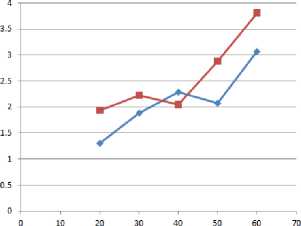
Number of nodes
■ OLSR-Orginal
■OLSR- Improved
Fig. 6: Throughput OLSR Original and OLSR Improved (Duration =

Fig. 7: Throughput OLSR Original and OLSR Improved (Duration =
Fig. 6 and Fig. 7 they show that, as the nodes number increases, our method has a significant improvement towards the conventional OLSR, because we eliminated the packages, which lasted long in the network and occupied more bandwidth, to free the bandwidth and consequently, the network serviced the other nodes sooner and finally, the total throughput volume increased considerably.
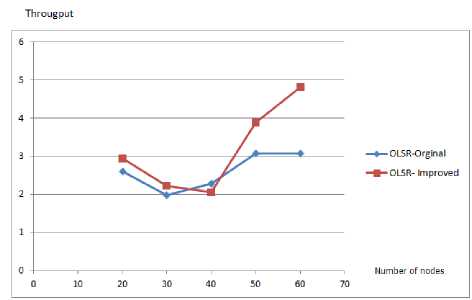
Fig. 8: Throughput OLSR Original and OLSR Improved (Duration =
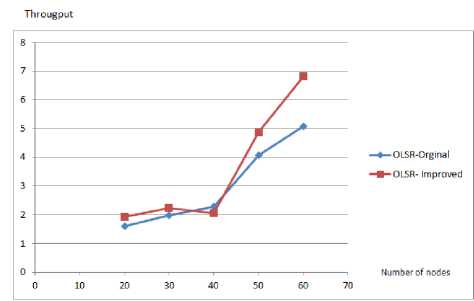
Fig. 9: Throughput OLSR Original and OLSR Improved (Duration = 60)
Fig. 8 and Fig. 9 they show the throughput at the times of 50 and 60, when the number of nodes reaches as 40, the conventional OLSR performs better than our method, but in the other nodes, our improved OLSR has the best performance.
Througput
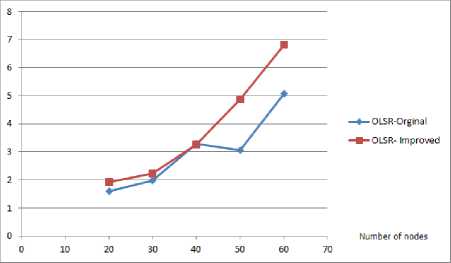
Fig. 10: Throughput OLSR Original and Improved (Duration = 70)
Fig. 10 it shows the throughput at the time of 70, when the number of nodes reaches as 40, the conventional OLSR has a performance similar to our method, but in the other nodes, our improved OLSR has the best performance
-
VIII. Conclusion
At this paper, we improved the OLSR routing protocol by eliminating the unnecessary loops. The results of the simulation show that the changed OLSR routing protocol (the suggested method) causes a significant improvement in the criteria of package delivery rate and throughput. The reason for this improvement is that, instead of eliminating all of the packages that fell into the loop, we gave theses package, by setting conditions, the second chance to reach the destination and consequently, in this case, more packages reached to the destination and finally, the package delivery rate and the throughput is improved by about 20 percent in comparison with the conventional OLSR.
Список литературы Improvement over the OLSR Routing Protocol in Mobile Ad Hoc Networks by Eliminating the Unnecessary Loops
- Y. Ge, T. Kunz, L. Lamont, Proactive QoS routing in ad-hoc networks in: Proceedings of the 2nd International Conference on Ad-Hoc Networks and Wireless, Montreal, Canada, October 2003
- Ivascu G. L., Pierre S., Quintero A., "Qos Support based on a Mobile Routing Backbone for Ad Hoc Wireless Networks", IWCMC, Canada, July 2006
- T. Clausen, P. Jacquet, Optimized link state routing protocol, IETF RFC3626, 2003.
- Li Tingjun, Lin Xueyuan, “GPS/SINS Integrated Navigation System Based On Multi-Scale Preprocessing”, Journal of Wuhan University, 2011, Vols 36(1): pp6-9
- P.E. Villanueva-Pena, T. Kunz, P. Dhakal, Extending networ knowledge: making OLSR a quality of service conductiveprotocol, in: Proceedings of the International Conference onCommunications and Mobile Computing, Vancouver, Canada, July2006, pp. 103–108
- Li Tingjun “Study On Airborne Single passive location Technology” Applied Mechanics and Materials Vols.58(2011) pp2006-2009
- S. Mahfoudh, P. Minet, EOLSR: an energy efficient routing protocol in wireless ad hoc sensor networks, Journal of InterconnectionNetworks 9 (4) (2008) 389–408.
- Li Tingjun “The Phonetic Complex Data Based on FPGA Key Engineering Materials”, Vols 475(2011), pp1156-1160.
- Hipercom Project, OOLSR Implementation of the OLSR Optimized
- T. Clausen, P. Jacquet, L. Viennot, Investigating the impact of partialtopology in proactive MANET routing protocols, in: Proceedings ofthe 5th International Symposium on Wireless Personal MultimediaCommunications, vol. 3, October 2002, pp. 1374–1378.
- P.Jacquet, P. Muhlethaler. A. Laouiti, L.Viennot,T. Clauseen, "Optmized Link State Routing Protocol draft-ietf-manet-olsr 05.txt", INTERNET-DRAFT,IETF MANET working group.
- T. Clausen, P. Jacquet, Optimized link state routing protocol, IETF RFC3626, 2003.
- NS -2, The ns Manual (formally known as NS Documentation)


